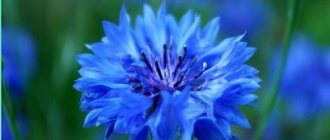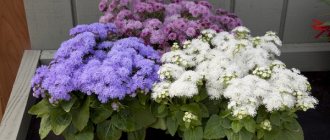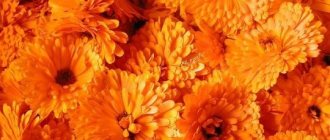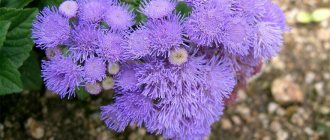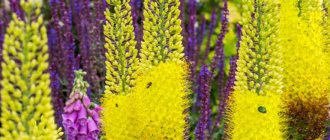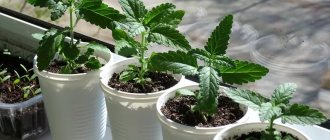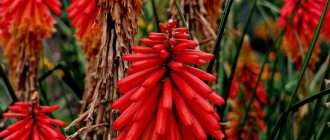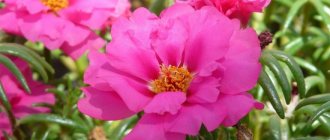Every gardener or flower gardener has a dream to have an incredibly beautiful flowerbed or front garden.
Miniature but lush flowers of ageratum will allow them to make their dream come true. To do this, you don’t need to spend a lot of effort, because this wonderful plant is not at all fussy to care for and has a fairly long flowering period.
There are more than sixty plant species, but our most popular is Ageratum Mexicana. In Russia it is most often grown as an annual
Planting and growing
Ageratum is grown by seeds and seedlings. Growing seedlings is considered a faster and more reliable method, in contrast to the long and labor-intensive method of growing seeds. When planting seedlings, use ready-made soil for hanging or terraced plants from a specialized store.
You can prepare the soil yourself by mixing soil with humus. Planting seedlings in the ground is carried out in the spring - April - May.
Growing seeds
Seeds are sown from February to the end of April. Small grooves are made in boxes with soil to a depth of 0.5 - 1 cm. Seeds are evenly distributed into the grooves and covered with soil.
Ageratum growing from seeds when to plant
The boxes are covered with film or glass to improve seed germination. The greenhouse effect created by this increases the temperature inside the box and retains moisture. To properly grow ageratum, the temperature should be maintained at least 20 °C. The appearance of the first shoots can be expected in approximately 2 weeks.
When 2–4 full-fledged leaves appear, seedlings are picked. The seedlings are transplanted into separate containers. After picking, young flowers should be watered generously. Due to their well-developed root system, ageratums easily take root in a new location.
Growing seeds - video:
Planting in open ground is carried out in a warm period of time, at a temperature of at least 20 °C. The heat-loving crop does not tolerate cold weather, so plants are planted not according to numbers, but according to weather conditions.
Picking seedlings - video:
When diving, it is recommended to use peat cups. When planting, seedlings are placed at a distance of 20 cm from each other.
Ageratum before planting in the ground
Preparing the soil and planting site
When planning to cultivate a flower in the garden, you must take a responsible approach to choosing a place to plant the plant. Since the garden crop is heat-loving, the site should have a light and non-acidic soil layer. The open area should be well lit and protected from drafts.
Garden crops cannot withstand slight darkening. If you plant the plant in a semi-shaded area, the foliage will begin to thin out, the stems will grow upward, and flowering will be insignificant. Therefore, when cultivating a flower outdoors or at home in a pot, you must choose a place that receives a large amount of sunlight.
The soil should be light, loose and have good drainage. Therefore, before planting the plant, you need to carefully dig up the beds. The soil layer must be fertile. If necessary, you will need to add fertilizer to the soil.
The acidity of the soil should be low, since the flower prefers to grow in soil with a neutral or slightly acidic reaction. If the soil on the site is characterized by an acidic reaction, the soil will need to be fed with dolomite flour or lime. It is not recommended to use humus or organic matter, as they have a bad effect on the flowering of the plant.
The soil layer for seedlings must be prepared in advance, approximately 14 days before sowing.
To do this you will need to do the following:
- First you need to make a substrate. To do this, you need to mix humus with peat and sand. All components should be taken in the same volume.
- The resulting composition must be disinfected. To do this, you need to pour it with a manganese solution.
- The prepared soil must be transferred to a warm place and left there until sowing.
- During this time, the necessary microflora will be restored in the soil.
Propagation by cuttings
Ageratum is usually propagated by seeds and seedlings. Compared to cuttings, these methods are less labor-intensive and are used more often. The method of propagation by cuttings is used for breeding hybrids and to achieve a bushy plant appearance.
Propagation of ageratum by cuttings
Preparation for cuttings occurs in the fall before the onset of frost. Flowers intended for propagation are transplanted from open ground into pots and brought into a warm room. With the onset of spring, side shoots up to 5 cm in size are cut off from the plants. The place of the cuts should be below the buds, where there is a special substance that further protects the mother plant from the effects of fungus and disease. Cuttings should be planted in a mini greenhouse. Planting in open ground occurs as with conventional planting of plant seedlings.
When to sow according to the Lunar calendar
The lunar calendar is simply an indispensable thing for a gardener or gardener; with its help you can understand what day is best to plant a particular plant. Fortunately, ageratum is no exception to this rule.
Favorable days for planting ageratum seedlings can also be determined by the lunar calendar.
Favorable days for sowing
Ageratum is completely easy to care for, so it can be grown both at home and in open ground. But all sowing and transplanting procedures must be carried out in accordance with the Lunar calendar.
The most favorable days for sowing:
- In January - 1, 5, 9, 11, 16-19, 22, 27-29;
- In February - 1-4, 6, 7, 12-14, 20, 24, 25, 28;
- In March - 3-6, 11-13, 17, 18, 22, 27, 28;
- In April - 1, 2, 7-10, 13, 18, 19, 24, 28, 29;
- In May - 5-7, 11, 12, 15, 16, 20, 25, 26.
If you want to succeed, then any vegetable and flower crop must be sown at the right time - not too late and not too early.
Bad days
The plants that you plant on favorable days will sprout together and grow healthy, but there are also unlucky days; on these days it is best to postpone any work in the garden.
Such unlucky days are:
- In January - 2, 3, 10, 25 and 31;
- In February - 8, 9, 21, 22, 26 and 27;
- In March - 7, 8, 19-21, 25 and 26;
- In April - 3, 4, 15-17, 20-22 and 30;
- In May - 1, 13, 14, 18, 21, 27-29.
These days, you can only care for the plants, for example, water them or hill them up, but planting and replanting ageratum is highly not recommended.
Watering ageratum
Flowers do not tolerate heavy flooding with water. For full development of plants, daily moderate watering is required. It is best to water in the morning. The moisture entering the soil gradually evaporates under the influence of sunlight, thereby allowing the flowers to receive important vital energy. During the flowering period, the watering dose should be slightly increased. The soil should also be kept evenly moist.
Top dressing
Good flower growth is facilitated by the addition of humus. In the absence of this fertilizer, you can use mineral or compost, strictly observing the required dosage. Excess fertilizers, including organic ones, can bring plants a small number of flowers with increased growth.
what does ageratum look like?
The result is a non-flowering voluminous bush. Stable flowering of ageratum is achieved by using nitrophoska and ammophoska at the rate of 20 - 30 grams of fertilizer per 10 liters of water.
Loosening and trimming
Constant care requires periodic loosening of the soil and removal of weeds. When weeding, you should loosen the soil with care to avoid damaging the roots that are close to the surface.
Restoring the flower after trimming the overgrown upper part is painless and quick. Withered and dry flowers are removed from the plants. This will create an attractive appearance, maintain a compact shape for the bushes, and also extend the flowering period.
Sowing Ageratum seeds in open ground
How to sow ageratum seeds in a flower bed? Carefully consider the choice of site and soil composition.
Ageratum is a tropical plant and to some extent capricious, for example, it will never grow on rocky soil even with very scrupulous care.
The soil for this flower needs light, nutritious, moderately moistened, but without stagnation of moisture, that is, give preference to flat areas without depressions in the relief, with groundwater not too close.
Soil acidity is preferably neutral.
Choose a sunny place for sowing, not located in drafts. When preparing the bed, add a little humus to the soil and add sand to the clay soil.
The best time for sowing is when the soil is consistently warm and the daytime air temperature is 22 degrees above zero.
Ageratum seeds are very small; to distribute them evenly into the planting grooves, mix them with sand. Make the grooves shallow, up to 2-3 cm, so as not to complicate germination. Keep the distance between them approximately 20-25 cm for dwarf varieties and about 40 cm for medium and tall varieties. Lightly sprinkle the seeds with moist soil.
Ageratum at home
Home conditions are perfect for flower development. Unpretentious plants grow well in spacious containers with a small amount of drainage at the bottom. In winter, they delight with friendly flowering. In summer, they are placed on the balcony, veranda or secured under the windows.
Simple rules for caring for ageratum at home will help preserve the decorative appearance of plants for a long time:
- The placement of flowers in the room should be on the south side of the apartment, near the windows, with plenty of warmth and light.
- Watering the plants should be done daily in the morning, with small doses at the root.
- Purchasing ready-made soil for ageratum, with the necessary content of microelements and organic substances, will allow the plants to receive useful nutrients. At the same time, the loose structure of the soil will give the roots constant access to air.
- Complex compositions of fertilizers must be applied once every six months.
- Overgrown flowers should be divided and planted in spacious containers.
Care for ageratum seedlings
The germination period of ageratum seeds is 8-10 days, in some cases it can reach 2 weeks. During this time, crops require daily ventilation and systematic soil moistening.
To ventilate, remove the lid or plastic wrap from the container and leave for half an hour. Greenhouse conditions should be maintained until seedlings emerge and then removed. Ageratum seedlings need regular moistening. Both drying out and increased soil moisture should not be allowed.
After the appearance of young shoots, the container with the plant should be placed in a well-lit place - on a windowsill, balcony.
For full growth and development, ageratum requires a 13-hour daylight hours, so in cloudy weather you can use additional lighting for the flower.
Diseases and pests
Ageratum is resistant to various diseases. Due to its tropical origin, it is an “unpalatable” plant for pests. However, despite its good resistance indicators, it is also subject to some diseases and attacks from dangerous pests:
- frequent planting and increased watering of plants leads to cucumber mosaic and bacterial wilt;
- most susceptible to invasion by aphids, whiteflies and spider mites.
Garlic tincture is the most effective folk method in pest control.
To prepare the tincture, use 220 grams of chopped garlic, poured into 1 liter of water. After 5 days, the mixture is diluted in 10 liters of water. The prepared tincture is applied using a sprayer to the infected areas of the plant. When making the tincture, you should carefully monitor the amount of garlic used in order to avoid burns to the plants in the future.
Both folk and industrial special means help to resist pests. In the fight against spider mites, it is recommended to use industrial products from insectoacaricidal preparations: Agravertin, Neoron and Nissoran. The following drugs will help you cope with whiteflies: Mospilan, Tanrek and Komandor.
Possible diseases and pests, ways to get rid of them
Ageratum (planting and care, photos will help growers protect the plant from diseases and pest invasions) can be susceptible to fungal diseases due to poor soil and high humidity. Insects can also harm the plant, so the flowers should be constantly inspected to identify spots on the leaves and other damage.
Rot is a fungal disease and appears as a result of high humidity. The first signs of the disease are black spots on the foliage.
After their detection, neighboring plants must be treated with Fundazol or Topaz.
Other drugs to combat fungal diseases are also suitable. If the treatment does not produce positive results, the diseased stems must be dug up and burned. The soil where the flower grew should be disinfected.
The presence of yellow spots on the foliage is a sign that the plant has cucumber mosaic. It is dangerous because it cannot be cured.
The only thing that can be done when a disease is detected is to separate damaged plants from healthy ones and burn them.
The main carrier of the disease is insects. As protection, you should regularly weed the area where the flower grows and plant insect repellent plants nearby.
Bacterial wilt is often confused with cucumber mosaic because the symptoms of yellow spots on the foliage are very similar. Unlike cucumber mosaic, the disease in the first stage can be cured with the help of the drug Coronet. The effect of the disease on the plant is manifested in the form of cracked stems and leaves, which leads to loss of moisture.
To reduce the risk of disease, it is necessary to promptly remove the weed growing next to the plant and feed it properly.
If small yellow dots appear on the foliage, it means the plant is infested with cutworms. The presence of white cobwebs indicates that the flower is heavily infected. The problem with treatment is that cutworms can adapt to chemicals very quickly. The main control is to use insecticides to treat infected plants.
Difficulties in growing and caring
When planting ageratum early, the color of the leaves may change to a lighter color due to low temperatures at night. In this case, timely hardening of seedlings with shelter during the cold night will be an effective preventive measure. Targeted hardening with removal of seedlings to the balcony is also possible. The following are used as shelter: cellophane, paper bags, cut-off bulky plastic eggplants.
If the ageratum is not watered correctly, the plant may turn black and rot. Abundant watering from above causes water droplets to be retained by the fuzzy top part of the plant. If there is insufficient ventilation, the flower will become moldy, with further negative consequences. In this situation, only the root method is a mandatory and correct condition for watering.
Protection from pests and diseases
Although ageratum is unpretentious, it can be susceptible to various diseases. With excess moisture and cold air, it is affected by root rot. There is no point in fighting her. Affected plants are dug up and removed to prevent the disease from spreading further.
The flower can also be affected by cucumber mosaic. The shoots become glassy, and yellow spots appear on the leaf blades. The buds do not bloom. Diseased areas of the plant must be removed. And treat the remaining ones with a fungicide or a decoction of tansy and wormwood.
Common ageratum pests:
- spider mite;
- nematode;
- whitefly
You can destroy parasites using insecticides:
- Intavir;
- Aktara;
- Karbofos.
Collecting seeds for planting
To obtain seeds for planting, flowers must be pollinated by bumblebees or bees. After the end of the flowering period of the plants, after approximately 2-3 weeks from the appearance of flowers, seeds are collected for future planting. The collected seeds are light brown in color, very light, have an elongated shape and small size. 1 gram can contain from 6 to 7 thousand pieces.
Seeds are best stored in paper or fabric bags in a cool, dry place.
When to plant seeds for seedlings
The timing of sowing ageratum is determined by the weather conditions of the area where it is cultivated.
Average sowing time in different regions:
- Central region – mid-March – early April;
- Northwestern region - mid-April;
- Ural – mid – end of April;
- Siberia - mid-April - early May;
- Central Black Earth and North Caucasus regions - mid-end of March.
Description of ageratum with photos of flowers
The southern tropical countries: Mexico and South America are considered the homeland of perennial ageratum. A large distribution of flowers can also be seen in the eastern part of India. In the climatic conditions of Russia, due to poor frost tolerance, the plant is grown as an annual. The developed root system adapts well to a new location. The heat-loving crop can grow in greenhouses and at home for many years.
Ageratum blue in the photo
The appearance of ageratum has a small bush shape with stems not exceeding 60 cm in length. Small bright green leaves from 3 to 4 cm completely cover the plant, creating a lush carpet. The decorative effect of the ground cover plant is provided by soft fibers that envelop the leaves, stems and flowers. The bushy part contains tubular flowers of blue and purple color, with petals in the form of long soft needles. The color range of flowers of ageratum varieties is represented by pink, white, lilac and other shades. Long flowering for up to 5 months, starting from May - June and ending in October, pleases others with its richness and amazing beauty.
Culture is widely used in landscape design. Goes well with many plants. Used in the design of carpet compositions. Capable of harmoniously filling empty spaces among representatives of other cultures. In demand in the work of designers and florists.
Description of the flower
The heat-loving plant ageratum in its natural environment positions itself as a perennial flower crop. The seeds of the plant were removed from the hot, humid tropics several decades ago. On continents with cooler climates, the flower plantings are grown as annuals.
If the plant is provided with good lighting throughout the warm period, the ornamental crop can grow as a perennial even in cooler regions of the country. Full access to sunlight is provided by planting seedlings along borders or in flower pots installed on the terrace.
Blooming ageratum in a flowerbed
Flowering branches of ageratum cut from a flower bed remain fresh for a long time; for this feature they are secretly called “ageless.” The plant does not adapt very well to a new planting location after replanting. Does not tolerate temperature changes. But even such capricious behavior is not able to stop amateurs from breeding flower crops.
Ageratum is grown from seeds. When mature, it is a small, fluffy, very attractive bush. The plant does not stand out for its special appearance, bright green flowers of extraordinary beauty. The plantings look like a foamy flowering path painted in delicate tones, the dense inflorescences of which look like small pompoms.
The stems of an overgrown bush in some species reach a height of 60 centimeters. The small, numerous flowers emit a wonderful aroma. The color range of flowering plants is varied. The color can be lilac, pink, yellowish. The color palette is multifaceted and this is the main highlight of the plant.
Petiole leaf plates have a bright green color. Depending on the variety, they have oval, triangular, and diamond-shaped shapes. The marginal part of the foliage is serrated. The shoots on which the buds form are erect, their surface is slightly pubescent. The flowers are small in size and collected in corymbose inflorescences.
One bush produces a large number of seeds per season. Harvested on time and well-ripened grains remain viable for several years. In regions with cold weather conditions, ornamental plantings have to be sown every year. Every thrifty gardener always has the necessary seed material.
Flower crops are divided into several groups based on growth. The tallest varieties grow up to 50–60 centimeters. Standard medium-sized species reach 30 centimeters. The smallest dwarf plantings have a height of no more than 15. The variety of varieties makes it possible to grow varieties in different color palettes and groups in flower beds.
Popular varieties of ageratum
Flower growers who want to add ageratum to their collection must first select a plant variety. Each variety of flower has its own merit.
Blue mink
The most popular of all varieties. This species has large flowers with a classic color. Numerous hybrids have been created based on this variety. The flower called Ageratum Blue Danube is the most beautiful. The hybrid of this plant is smaller in size compared to the mother variety. The main difference between this type of ageratum is its unusual purple color of the flowers.
Mexican
The variety has a second name - Houston's ageratum. The size of the flowers is larger than that of "Blue Mink". It can reach a height of up to 50 cm. The variety contains two subspecies: shrubby and herbaceous. The flowers are light blue with a lilac tint, collected in corymbose-shaped inflorescences. The plants are photophilous, adapt well to bright sunlight and are not afraid of high temperatures.
Ageratum mexican photo
Summer snow
This species has a miniature and not too branched bush form. Small leaves of rich light green color. Lush white flowers are collected in complex umbrella-shaped shields, which are densely distributed over the surface of the bush. Long flowering occurs from early June to late autumn. Flowers tolerate heat well. The variety is grown on the borders of flower beds and in flowerpots.
Agerantum white Summer Snow
Pink ball
It is the best annual ground cover variety. During flowering, a small branched bush is hidden by a bright cap of fluffy and fragrant pink flowers. Blooms intensively from mid-June to mid-October. There are large pubescent leaves. The sun-loving plant grows well in nutritious soil. Used to decorate flower beds for various purposes.
ageratum pink ball
Bonjour
The variety of annual plant is a low bush about 25 cm high. Flowering from the beginning of June lasts until the onset of the first frost. Large corymbose inflorescences contain fragrant multi-colored flowers. The light-loving and drought-resistant species can be grown in light shade. Flowers are an original decoration for balconies, flower beds, ridges and mixborders.
ageratum bonjour
Snow blanket
The ground cover variety is strewn with snow-white flowers, which are collected in fluffy paniculate inflorescences. A low spreading bush reaches a height of up to 25 cm. The flowers of this variety cover a flowerbed, flower garden, border with a luxurious white “blanket”, harmoniously combining with other flowering plants.
ageratum snow blanket photo
White ball
Small flowers resemble fluffy white balls, densely dotted on small spherical bushes. Drought-tolerant plants grow in any soil. Tolerates sun and partial shade well. They are distinguished by abundant flowering until the onset of frost. The combination of this variety with red, blue, pink and purple flowers of other ageratum varieties presents a mesmerizing and impressive appearance. Plants are grown to decorate flower beds, balconies, borders, and rocky hills.
ageratum white ball photo
Aztec Treasures
The excellent characteristics of the variety distinguishes this species from other types of ageratum. Grown by seedlings. Long-term abundant flowering pleases the entire summer period until the first autumn frosts. The wide range of colors of flowers looks harmonious in a decorative flowerpot, in any flower bed, and also when creating spectacular borders.
Ageratum Aztec treasures photo
How to plant depending on the region
It is no secret that climatic conditions vary greatly in Russia. The weather in each region is completely different, so the timing of planting ageratum will vary greatly.
If you plant ageratum seedlings too early, the seedlings will not get enough sunlight, they will be weak and elongated
In Moscow and Moscow region
It is best to sow ageratum for seedlings in this region somewhere in mid-March, when the sprouts sprout; it is best to transplant them in May. Or rather, when the air temperature warms up to 22-25 degrees.
In the middle zone
In central Russia, seedlings are best prepared in March, but transplanting into the ground should be done in May, or rather, when the night frosts have passed
In the Urals
Here the planting date will no longer be in March, but in May, preferably in the middle. Flower crops should be planted in open ground a month after the first shoots appear.
In Siberia
In Siberia, the best time to plant ageratum is in April, and transplanting into open ground is best done at the end of May or early June.
In the Leningrad region
When transplanting a flower crop into open ground in this area, it is best to focus on weather conditions, but planting should begin in mid-April.
Ageratum in temperate climates should be planted every year, as it is not adapted to severe winter frosts. This makes it possible to constantly experiment with varieties, purchasing different seeds every year
Ageratum variety, which one is better to choose?
Ageratum is a completely unpretentious crop; it does not require special treatment, so gardeners like to plant several varieties of this wonderful plant on their plot.
The varieties that summer residents and gardeners most often use in their flower beds and gardens:
- Alba. This variety of ageratum is completely covered with rather large and large inflorescences; white button-like flowers bloom on this plant;
- Blue Mink. The name of this variety was not taken out of thin air; the flowers of this plant have a blue-violet color scheme. They will look great in a flowerbed with other Ageratumak varieties;
- Summer Snow. If you want to recreate the clouds that are in the clouds in your flowerbed, then this option is for you. The flowers of this variety are large white buds;
- Blue Lagoon. The flowers of this variety are spherical in shape and the colors range from light lilac to dark lilac;
- Blue Lagoon. If you like small and neat flowers, then you will definitely like this variety. Its flowers are bright blue in color.
Ageratum planting sites
The ornamental crop is widely used for home and garden decoration. It grows most in the flower bed. When planting several varieties, a beautiful flower meadow is obtained. The combination of plant varieties with red and yellow flowers of other crops elegantly and effectively decorates any flower bed. Also used for decorating borders and alpine slides.
To create expressive flower arrangements, ageratum is grown with other decorative flowers: zinnia, marigold, calendula and many others.
A light-loving plant that requires a lot of sun and space. Planting in a shady place is not suitable for flowers; they grow more tall and lose their aesthetic appearance. For planting, choose soil that is fertile and neutral in chemical composition. Rotted manure is used as fertilizer, which, unlike fresh manure, does not burn plant roots. In poorly ventilated soil, drainage is done to avoid rotting of the root system. To do this, a layer of gravel is laid under the top layer of soil.
The best varieties of ageratum are rightfully popular and in demand among many gardeners. An unpretentious plant, when planted in a timely manner and properly cared for, gives all its connoisseurs an abundance of bright colors.
Ageratum: types and varieties for open ground
About 60 types of crops grow in nature. Shrubs are tall (about 60 cm in height), medium tall (up to 30 cm), and dwarf (10-15 cm). But only some types of ageratum and their varieties are cultivated.
Blue or Blue Mink
Low branched shrub up to 25 cm in height. The inflorescences are lush, soft blue, reminiscent of mink fur. The diameter of the inflorescences is 5-8 cm.
Mexican or Houston
Compact spherical bush. Its height can vary between 10-60 cm, depending on the variety. The leaves are diamond-shaped or oval and may have jagged edges. The flowers are small, collected in small inflorescences-baskets.
Popular varieties of Mexican ageratum:
- Alba,
- Azur Pearl,
- Faye Pink,
- Blue Mink,
- Blue Bouquet,
- Blausternchen.
Ageratum: description
The genus Ageratum belongs to the genus of the Astrov family. It grows naturally in eastern India and America. Garden varieties have become widespread all over the world, including in Russia. The name of the flower comes from the Greek word ageratos, which means “ageless.” This is due to the fact that the plant is able to maintain a fresh blooming appearance throughout the entire season. The genus contains from 40 to 60 species.
Ageratum is considered a perennial herbaceous or semi-shrub crop, but in Russia, due to the climate, it is grown as an annual plant.
The branches of the longflower are numerous, strongly branched, and erect. Stems are pubescent. The flower grows from 10 to 50 cm in height. The leaves have a triangular rhombic or oval shape, their edges are jagged and rough. The lower middle leaves are located opposite, the upper ones are alternate, almost sessile.
Ageratum flowers are small, bisexual, narrow-tubular. They have a scent. Connected together into baskets with a diameter of 1-1.5 cm. Baskets with spherical flowers are collected in thyroid inflorescences up to 10 cm in diameter. The beauty of ageratum inflorescences comes from the two-lobed stigmas of the flowers; they are 2 times the length of the perianth.
The pentagonal seed pods have a membranous tuft. Able to maintain germination for two to three years. 1 g of such capsules contains up to 6000 seeds. The seed pods ripen in early September.
Ageratum blooms abundantly and long-lasting, from May until the first frost. Peduncles in low-growing species are formed in several tiers. In medium-tall ageratums, the peduncles are at the same level, and if such flowers are planted in one group, then the impression of a continuous flower carpet is created. The colors of the flowers are quite varied: white, blue, pink, yellow, red, etc., which gives flower growers the freedom to experiment.
Ageratum plant is drought-resistant and light-loving.
